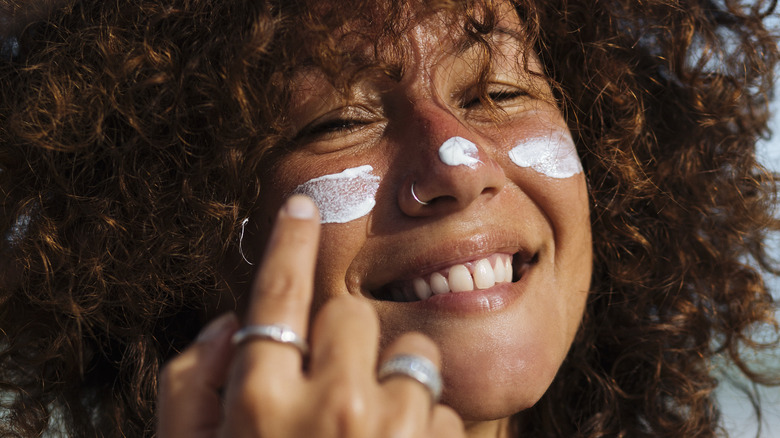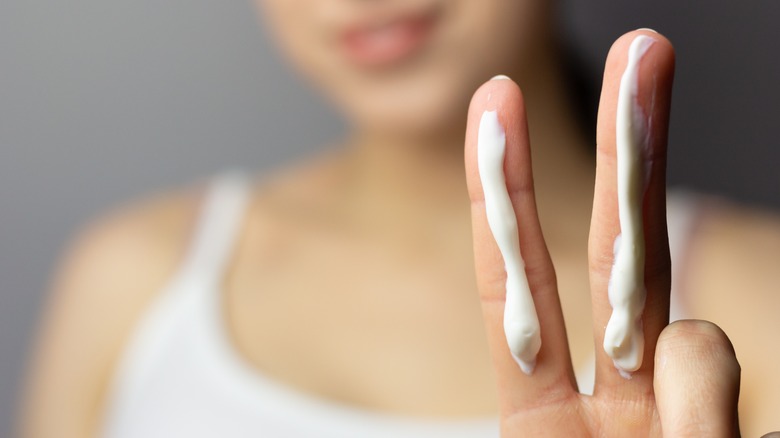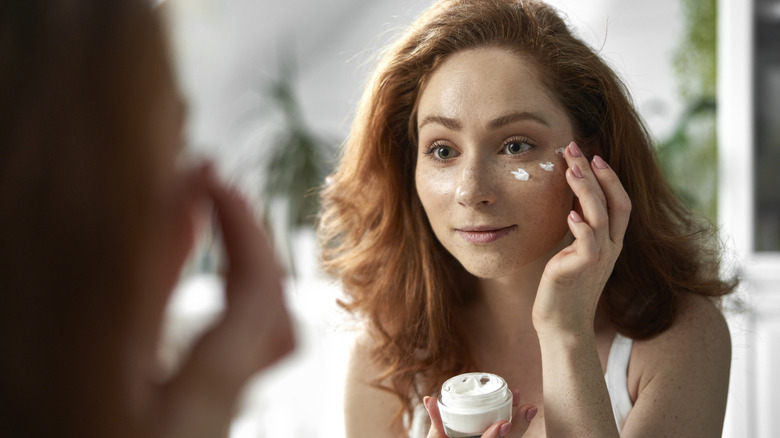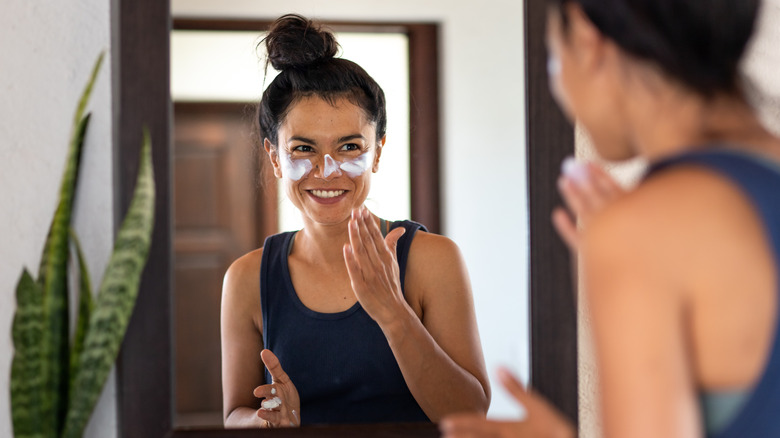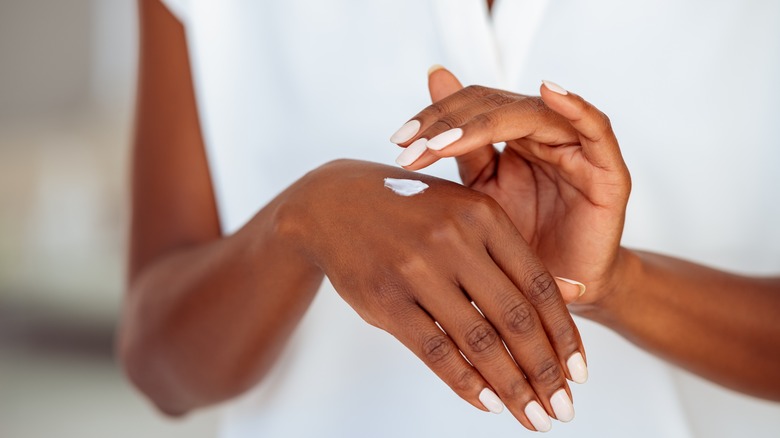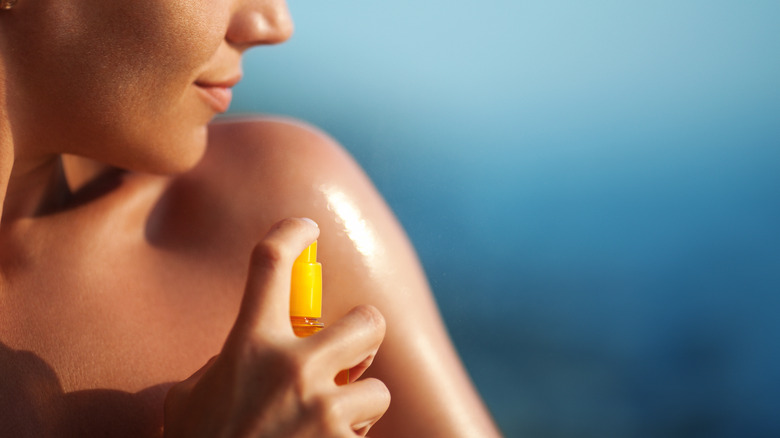Say Goodbye To The Dreaded White Cast From Mineral Sunscreen With These Tips
Long gone are the days of sunscreen as a second thought, found tucked away on limited shelf space in pharmacies with only the Coppertone baby, sunbathing (or rather, baking) oils, and a few thick white-casts to pick from — and for good reason. Regardless of skin type or complexion, sunscreen is non-negotiable. It acts as a shield against harmful UV rays to stave off sunburns, and in doing so, also helps prevent premature aging and the risk of developing skin cancer.
There are primarily two types of sunscreens: chemical and mineral. The former contains active chemical ingredients designed to absorb and convert UV rays into heat, typically having a lighter texture that blends more easily into the skin compared to mineral sunscreens. The latter contains active mineral ingredients, like titanium dioxide and zinc oxide, that form a protective barrier on the skin's surface, reflecting and scattering the UV rays away from the skin. While this formulation is considered gentler and safer for the skin since it lacks potentially irritating chemical ingredients, mineral sunscreen has faced criticism due to its chalky white cast that makes it difficult to blend seamlessly into the skin — especially for those with darker skin tones.
Luckily, technology's advancements in the beauty space have led to formula developments and application techniques that improve texture, reduce white cast, and make mineral sunscreen easier to blend. Follow these key tips to make the most out of your mineral sunscreen.
Use the correct amount of sunscreen
While you probably already know that you should reapply sunscreen every two hours for maximized protection, how much of it should you actually be applying? To achieve the SPF level on the packaging, you'll have to replicate the amount of sunscreen applied in the labs where it was tested. In an interview with Allure, board-certified dermatologist Marisa Garshick shared that the recommendation is two milligrams of sunscreen per square centimeter of skin. "[This] is equivalent to one shot glass for the body or two tablespoons," Garshick continued. "For the face, it is recommended to apply a nickel-sized dollop — the equivalent of two finger lengths, which is also equivalent to half a teaspoon, to the face and neck combined."
Realistically, this exact amount of product may not be applied every time. The two-finger method, wherein two fingers worth of sunscreen on your index and middle fingers are used as a measurement before applying to your face and neck, is an effective way to gauge if you're using enough product or not. It's also especially useful when applying sunscreen on your skin throughout the day.
Apply immediately after moisturizing
Just as you would put on makeup right after applying a primer, you should put your sunscreen on immediately after moisturizing. Attempting to blend anything on dry skin is not only difficult but harsh on your skin too. Applying sunscreen after moisturizer will help it absorb more easily and forgo that pasty white cast, instead giving a hydrated, glowing look. Board-certified dermatologist Karan Lal shared in an interview with Refinery29 that, "a little moisture will help you spread the mineral sunscreen, applying on dry skin can make you look very white."
Timing how long you massage the sunscreen into your skin can also be helpful. Dr. Lal clarified that rubbing the product in for at least three to five minutes can help ensure an even application and overall finish. If you're also looking to wear makeup, mixing drops of a liquid foundation with mineral sunscreen can provide thorough facial coverage and blend more easily with your skin tone.
Apply in layers
While the correct amount of sunscreen has already been established, it can definitely seem like a lot of goop (not a Gwyneth reference!) to put on your face and neck all at once. The trick to effectively apply the necessary amount of sunscreen is by doing it in layers. Instead of slathering on a thick layer all at once, apply it in multiple thin layers to provide better absorption and fuller coverage. Mineral sunscreens are known for the tendency to leave a white cast, so with an evenly distributed volume of subsequent layers, that chalkiness won't seem so inevitable.
Start by taking a small amount off your two sunscreen-filled fingers — if following the two-finger method — and thoroughly, but gently, massaging it into the skin until it's seamlessly blended in. Once it's set and settled, apply the next layer and repeat this process until you've achieved the requisite amount of sunscreen coverage.
Allow it to set
It's easy to think that how the globs of sunscreen initially look on your face upon first application is how it will remain for the next couple of hours before reapplying more, so don't be dissuaded by this. Sunscreen needs time to set into your skin, so you should be applying it around twenty minutes before going outside; this also allows your skin to actually absorb the product.
While sunscreen's formulas often vary in texture and consistency, as they are designed to quite literally block UV rays from harming your skin (they're not formulated as oils or serums for a reason) it can be helpful to opt for lightweight and non-greasy formulas that settle on the skin more easily. Giving yourself ample time to gently and slowly rub it in prior to sun exposure, and allotting time within that for your skin to truly soak in the sunscreen, is the difference between having a chalky cast sit atop your skin versus making the most of the mineral ingredients' efficacy.
Try sunscreen spray
Whether it's in lotion or spray form, it is all about the blending technique. Opting for a spray version of mineral sunscreen can offer a more lightweight solution that may spray on white, but blends more easily than lotion with a sheer finish. The spray delivery system allows for a lighter and evenly-distributed application, helping to avoid a layer of white chalkiness on the skin. The finely milled particles in the spray formulation help minimize the risk of a visible white cast to ensure a more seamless and natural look.
Additionally, mineral sunscreen sprays offer the advantage of being easy to reapply every two hours throughout the day, making it a convenient choice for on-the-go sun protection. It is vital, however, to follow proper application techniques, such as holding the bottle close to the skin and spraying in a sweeping motion, before then thoroughly massaging it in for full coverage and effectiveness.
